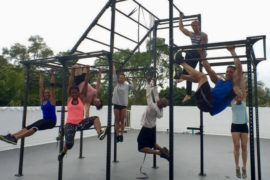Houlihan Lawrence describes itself as “the future of real estate since 1888.”
That’s when William Van Duzer Lawrence founded the firm in Bronxville, where he helped define the American suburb — sculpting tony Lawrence Park and developing Lawrence Hospital. (In neighboring Yonkers, Lawrence created Sarah Lawrence College in honor of his late wife, the former Sarah Bates.)
It was George Lawrence, William’s great-grandson, who would merge what was then Lawrence Properties with Art Houlihan’s A.T. Houlihan, a northern Westchester firm that gave Lawrence countywide access.
George sold Houlihan Lawrence to Peter and Nancy Seaman in 1990. Nancy and her two brothers, Stephen and Chris Meyers, turned it into the top brokerage north of New York City. Today, the firm’s 1,300 agents in 30 offices serve the counties of Westchester, Putnam, Dutchess, Columbia, Orange and Ulster in New York and Fairfield County in Connecticut.
Recently, we asked Tom LaPerch, director of Houlihan Lawrence Commercial, and Debbie Doern, senior vice president of sales for Houlihan Lawrence, respectively to paint a commercial and residential real estate picture for us. You would imagine that with many people fleeing to the ’burbs and working from home during the pandemic that the residential real estate landscape would be rosy and the commercial one not.
But while residential real estate remains hot, the commercial market is looking up:
Commercial real estate — bloodied but unbeaten, unbroken and unbowed
Tom LaPerch, director of Houlihan Lawrence Commercial, is an optimist. “That’s what my wife says,” he notes with a laugh. As he views the commercial real estate picture in the Hudson Valley and Fairfield County, he generally likes what he sees.
“The pandemic hurt demand but not as greatly as anticipated,” he says. “The government money softened the landing in a big way.”
To be sure, he says, “some sectors were trending toward a bubble” before the coronavirus hit in March of last year. These sectors include hospitality, where the costs of restaurant rents and renovations were on the rise.
But if the coronavirus has taught us anything, it’s that those who survive and thrive learn to reinvent and repurpose. A second generation of restauranteurs is taking advantage of what LaPerch calls “a 20% to 50% rate reduction” in vacated properties to open new establishments or create “ghost kitchens” that do only takeout and delivery.
Similarly, retail was already in reimagination mode pre-pandemic, thanks to the ascent and domination of e-commerce, LaPerch says. Stores have reduced their footprint 20% to 50%, though they’re still needed on Main Street, he adds. Elsewhere, retail continues to recreate itself, with malls turning into “last mile,” or last stop, delivery hubs for e-commerce, particularly along the I-84 corridor in Danbury and Putnam, Dutchess and Orange counties. Look also to see former retail properties go mixed-use, as with the Kmart site in Yorktown.
But what everyone is wondering is, What’s going to happen to the office market, as people return to in-person work or some kind of hybrid at-home, at-the-office arrangement?
“Everyone has been predicting its demise, but it’s never happened,” LaPerch says. He credits developers like Robert Weisz, who’ve outfitted their class-A buildings with air filtration systems and other accommodations to CDC (Centers for Disease Control and Prevention) protocols.
“Weiss has done a fantastic job and has held his pricing.”
As for the Class B and C buildings, LaPerch says we have to “wait and see. The first quarter of next year will tell the tale.”
Nonetheless, he remains bullish. The pandemic is the third crash he’s been through, after the dot.com bubble burst of 2000 and the Great Recession of 2008-09. The difference between then and now is that the market has been mostly up, 401k plans are fat and “money is cheap,” allowing for transitions and opportunity.
“This is a good time to be a broker,” he says.
Residential real estate —
from hot, hot to hot
with a bit of caution
We all know what happened to residential real estate in 2020: As the pandemic took off, so did the exodus from New York City — the most populous and densely populated city in the United States, one of the world’s largest megacities and the center of its largest metropolitan area as measured by urban area.
“What really did happen: It was a fear-based move,” says Debbie Doern, senior vice president of sales for Houlihan Lawrence. “We had no seasonal downturn. Usually things slow down in the summer…. Before Covid, we had historically low inventory.”
After the coronavirus exploded, so did the search for homes in the Hudson Valley and Fairfield County, with “mortgage banks doing preapplications for (potential homebuyers for) multiple communities.”
Homebuyers, she adds, “were not focused on one area. In the past, their searches were more targeted.” During the height of the pandemic, “there was more urgency.”
Overall, Westchester County saw a 43% increase in home sales year over year with one-third of its buyers coming from New York City. Some towns in Houlihan Lawrence’s market saw a 50-plus% increase year over year. And while luxury homes did well, the bidding wars were in the moderately priced range.
Now things are “starting to normalize,” Doern says, and buyers are becoming “more cautious.” But the hunger is such that there are some who still don’t have houses. And, she adds, “for the first time, all areas are in high demand as are all price points.
“Buyers looking for homes are still uncertain if they’ll be going into the city full-time. That’s why they don’t mind the distances. The commute is not as critical if you don’t plan to be in the office very day.”
It’s part of the reason that places like Dutchess County, once the hinterlands, are seeing a labor shortage as buyers snap up available workers for repairs on their new nests. Goods are also in short supply, although that is a problem that cuts across many industries.
New York, a city that has reinvented itself many times in its almost 400-year history, will come back, Doern says, though it will be slow-going.
In the meantime, the suburban hunt is on.
For more, visit houlihanlawrence.com.





